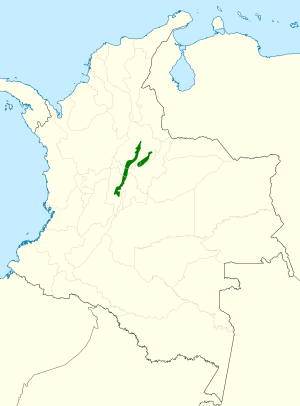Black inca facts for kids
Quick facts for kids Black inca |
|
|---|---|
 |
|
| Conservation status | |
| Scientific classification | |
| Genus: |
Coeligena
|
| Species: |
prunellei
|
 |
|
The black inca (Coeligena prunellei) is a type of hummingbird found only in Colombia. It belongs to a group of hummingbirds called "brilliants."
Contents
What is a Black Inca?
The black inca is a unique hummingbird. It was first described in 1843. It is closely related to the bronzy inca and the brown inca. This bird is "monotypic," which means it is the only species in its group.
Appearance
The black inca is about 14 cm (5.5 in) long. It weighs around 6.6 to 7.0 grams (0.23 to 0.25 oz). Both male and female black incas have a long, straight, black beak. They also have a small white spot right behind each eye.
Adult male black incas have purplish-black feathers on their upper body. Their shoulders are a shiny dark metallic blue. They have a black tail that splits into two points, like a fork. Their lower body is also dark purplish-black. They have a bright, shiny blue-green patch on their throat, called a gorget. There's also a white patch on each side of their chest.
Female black incas look similar to males. However, their colors are not as bright. Their beak is a bit longer, and they have less blue on their shoulders. Their tail is also not as deeply forked. Young black incas are duller in color than adults. They do not have the bright gorget on their throat.
Where They Live
The black inca lives only in Colombia. You can find them on the western side of the Eastern Andes mountains. This area includes parts of Santander, Boyacá, and Cundinamarca departments. They also live on both sides of the Serranía de los Yariguíes mountains in Santander.
These birds mostly live deep inside humid montane forests. They especially like forests with many oak trees. However, male black incas can also be seen in smaller, broken-up forest areas. They are sometimes found in places changed by humans. They live at heights between 1,200 and 2,800 meters (3,900 and 9,200 ft) above sea level.
How They Behave
Movement
Scientists do not know much about how the black inca moves around. It is not known if they migrate or stay in one place all year.
What They Eat
The black inca mainly feeds on nectar from flowers. They often follow a specific path, visiting many different flowering plants. This is called "trap-lining." Sometimes, they will protect a patch of flowers if there are many of them.
They drink nectar from flowers at mid-levels inside the forest. They also feed at lower levels along the forest edges. They prefer red and yellow tube-shaped flowers. Some of their favorite plants include Fuchsia, Bomarea, and Palicourea. They like native plants best when there are many available. But they will also visit plants like Abutilon and other introduced species. Besides nectar, black incas also eat small arthropods (like insects or spiders). They pick these tiny creatures off leaves.
Breeding and Nests
The breeding season for the black inca is not fully known. It might last from June to February. Only two nests have ever been found. These nests were shaped like cups. They were made from tree fern scales glued together with spider silk. The inside was lined with soft plant down. Both nests were found inside oak forests. They were placed about 1.5 to 1.8 meters (4.9 to 5.9 ft) above the ground. We do not know how long it takes for their eggs to hatch or for the young birds to leave the nest.
Sounds They Make
The black inca is usually a quiet bird. But it does make short "ick" or "pip" sounds.
Conservation Status
The IUCN (International Union for Conservation of Nature) has changed its assessment of the black inca several times. Currently, it is listed as "Vulnerable." This means it is at risk of becoming endangered.
There are fewer than 10,000 adult black incas left. Their numbers are believed to be going down. Colombian authorities consider this bird to be endangered. About 90% of the forest where they live has been cut down. This land is used for homes or farms. The remaining forest is broken up into smaller pieces. This makes it harder for the black incas to find food and safe places to live.
See also
 In Spanish: Príncipe de Arcabuco para niños
In Spanish: Príncipe de Arcabuco para niños


